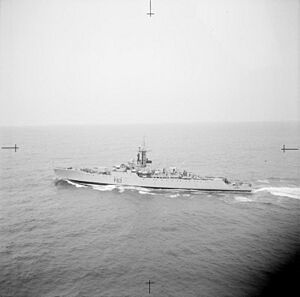HMS Scarborough (F63) facts for kids

HMS Scarborough, February 1960
|
|
Quick facts for kids History |
|
|---|---|
| Name | HMS Scarborough |
| Ordered | 6 March 1951 |
| Builder | Vickers Armstrongs, Newcastle upon Tyne |
| Laid down | 11 September 1953 |
| Launched | 4 April 1955 |
| Commissioned | 10 May 1957 |
| Decommissioned | 1972 |
| Identification | Pennant number: F63 |
| Fate |
|
| General characteristics | |
| Class and type | Whitby-class frigate |
| Displacement | |
| Length |
|
| Beam | 41 ft (12.5 m) |
| Draught | 17 ft (5.18 m) |
| Propulsion | Powered by two powerful steam turbines, giving her 30,000 horsepower (22 megawatts) |
| Speed | 30 kn (56 km/h) |
| Range | Could travel about 4,200 nmi (7,780 km) at 12 knots (22 km/h) using 370 tons of oil fuel |
| Complement | 152 crew members, later increased to 225 |
| Sensors and processing systems |
Equipped with advanced radar systems to detect targets in the air and on the surface, and sonar systems to find objects underwater |
| Armament |
|
HMS Scarborough was a special type of ship called a Whitby-class frigate, built for the Royal Navy of the United Kingdom. Her main job was to find and stop enemy submarines, making her an important anti-submarine warfare vessel. She was named after the lovely town of Scarborough in the county of North Yorkshire.
Contents
About HMS Scarborough
HMS Scarborough was a modern warship designed to protect other ships from underwater threats. She was part of a group of ships known as the Whitby-class frigates, which were built after World War II to be fast and effective at hunting submarines.
Building and Design
The construction of HMS Scarborough began on September 11, 1953, at the Vickers Armstrongs shipyard in Newcastle upon Tyne. She was officially launched into the water on April 4, 1955, and then completed her fitting out. The ship officially joined the Royal Navy on May 10, 1957.
As a Whitby-class frigate, she was specially designed to hunt and destroy submarines. These ships were known for their speed and advanced equipment for finding underwater threats.
Life at Sea: Operational Service
After joining the Royal Navy in May 1957, HMS Scarborough became part of the 5th Frigate Squadron. She even led this squadron in March 1959 and participated in "Navy Days" in Portsmouth, where people could visit and learn about the ships.
Over the years, she had different commanders, including Józef Bartosik from 1959 to 1961, and P. W. Buchanan from 1961 to 1962.
The ship underwent a major update and repair period in Portsmouth from December 1962 to February 1964. After this, starting in April 1964, she joined the Dartmouth Training Squadron. Here, she helped train new sailors alongside her sister ships, Eastbourne, Tenby, and Torquay.
Ship's Features and Technology
HMS Scarborough was a fast ship, able to reach speeds of up to 30 knots (about 56 kilometers per hour). She was powered by strong steam engines that gave her a lot of energy to move quickly through the water.
Her main job was anti-submarine warfare, so she was equipped with special tools. This included advanced radar systems to spot things on the surface and in the air, and sonar systems to listen for and locate submarines deep underwater.
For defense, she carried a large twin 4.5-inch (114 mm) gun, a smaller 40 mm Bofors gun, and special 'Limbo' mortars designed to fire charges at submarines. She also had torpedo tubes, which are used to launch torpedoes at enemy vessels.
End of Service
HMS Scarborough served the Royal Navy until 1972, when she was decommissioned, meaning she was taken out of active service. She was later sold in 1977 to be recycled for her materials, marking the end of her long and important career.

